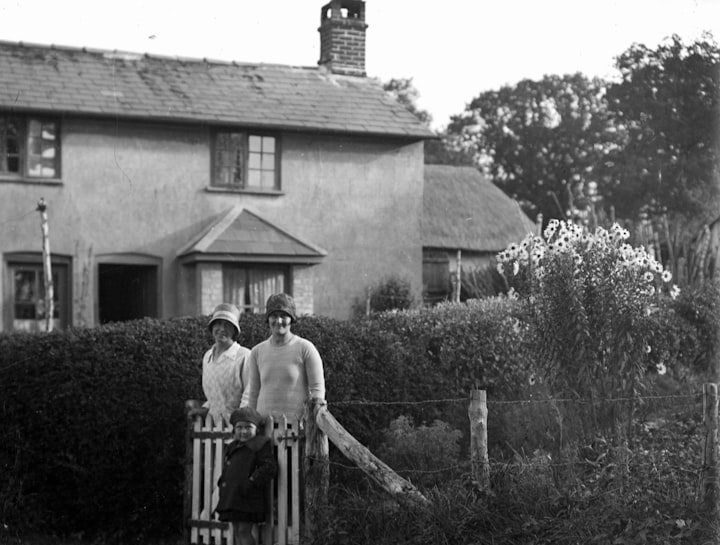What led to Roe v. Wade?
A look at the historical moments leading to 1973

Friends,
Rarely would I even consider writing a politically charged blog. It is almost considered a downfall to have an opinion one way or another. To have one is to be cast as a 'Karen,' a trouble maker, or dismissed as either a Democrat or Republican as if either of these political party titles makes you a bad guy. With passions running high, arguments for and against laws, regulations, or medical procedures have caused even the best of friends to question the morality lines of each other.
However, in light of the recently leaked Supreme Court ruling that may overturn the 1973 Roe v. Wade decision in legalizing abortion in this country- I thought maybe some historical context to the argument was necessary. As with many of my blogs- I derive my knowledge from history and current statistics, bowing to only what is written, studied, and analyzed as fact.
Due to the abundance of historical moments that led to Roe v. Wade, I will narrow this overview to the events leading to the 1973 decision. This attempt could be considered a long jump because of the hundreds of side stories in America that were happening all at one time to decide if women were legally able to obtain an abortion and whose authority could overrule it. There is no simple way to write the story...
But let's try!
Even during the seemingly cold, dark, and unforgiving times of the Puritan's arrival in America and thereafter, the standard was the Common English laws that allowed women to choose when and if they would become mothers. This decision was legal as long as the woman decided before the quickening (feeling the baby's movement for the first time), a defining moment recognized by women and the law in human development. Moreover, this common law assumed that women had a fundamental right to bodily integrity.
How do we know this for a fact? Early American medical books had instructions for 'suppressing the courses' or inducing an abortion; by the mid-18th century, the most common means of inducing abortion was commercialized. The availability of these drugs was so well known that there is a euphemism to describe their use- 'taking the trade.'

I need to point out that while it was generally acceptable, there was a growing concern about drugs used to cause an abortion. The first fundamental laws against it were not directed toward the act of abortion itself but rather illegalized the use of the poison which had been known to kill the user. However, the law did not punish the women for inducing abortions, nor did it eliminate the possibility of growing the herbs and plants in your garden.
What changed? A few different things that all are happening simultaneously.
In 1847, the American Medical Association was founded and made outlawing abortions one of its highest priorities. By 1857, the AMA stated that abortion was an immoral act and a medically dangerous one that should not be left in the hands of untrained women. In addition, the AMA was in the process of standardizing medical procedures that were to be adopted across the country. In these new foundational structures- women were not fit to become doctors.
Until the mid-1800s, the Catholic Church accepted early abortion; however, in 1869, the church started to condemn the practice leading up to 1895 when it included therapeutic abortions- or procedures to save a woman's life by terminating the pregnancy.
These two events helped fuel a crusade that started in 1857 when physicians in the country wanted complete control over the medical practice and restriction of their competitors- midwives and homeopaths.
In a male-dominated world- women were seen as inferior in their knowledge of how the human body worked- and yet, up to that point, rarely was a man ever seen in a birthing room; it was considered 'women's work.' However, doctors believed that women might be 'experiencing' pregnancy and birth- but they needed a doctor to translate what their bodies were doing, giving the doctors an advantage over a woman's knowledge of her own body.
If each woman were allowed to judge for herself in this matter, her decision upon the abstract question would be too sure to be warped by personal considerations, and those of the moment: Woman's mind is prone to depression and, indeed, to temporary actual derangement, under the stimulus of uterine excitation..." HR Storer, 1866
But why? Why would doctors all of a sudden show concern over women and childbirth? And why would a nation that was usually wary of anyone claiming to be Catholic be siding with the Pope? Because, in the mid-1800s- affluential families (married, white, upper class, Protestant) were smaller. Women from this class designation were using abortions to space out or limit the number of children they had, which went against the very foundation of a women's role in society as mothers and homemakers. And at the same time, immigrants, especially Catholics and nonwhites, were adding to the population boom in the country. This was cause for concern:
'Would the west...be filled by our own children or by those of aliens? This is a question our women must answer; upon their loins depends the future destiny of the nation." HR Storer, 1868
Another critical fact to offer is that there were no birth control opportunities at this point. The first rubber condom was produced in 1855; however, in 1873, the Comstock Act criminalized the use of the U.S. Postal Service to mail 'any obscenity, contraceptives, abortifacients, or sex toys and authorized the postal service to confiscate birth control sold through the mail.' The U.S. Court of Appeals for the Second Circuit in U.S. v. One Package did not retract this law until 1936.
By 1900- every state had a law forbidding abortions, though most states did have a therapeutic exception where the physician could provide abortions if they believed it would save the mother. In hindsight- this made doctors the judge, jury, and arbiters of the morality and legality of abortions- and opened the door for a lucrative side business in the black market for women who could not obtain abortions through the medical field.

How do we know this for a fact? In 1888, an undercover reporter known only as 'Girl Reporter' visited more than 200 doctors over three weeks, pleading to various doctors that she required an abortion. In her notes, she documented fees ranging from $40 to $250.00, an enormous sum for a black street surgery that may or may not work. Doctors on her list included the President of the Chicago Medical Society- Dr. J.H. Etheridge, and many other prominent members of the medical field.
According to When Abortion Was a Crime by Leslie J. Reagan
Some late-nineteenth-century doctors believed there were two million abortions a year. In 1904, Dr. C. S. Bacon estimated that "six to ten thousand abortions are induced in Chicago every year." As one physician remarked in 1911, "Those who apply for abortions are from every walk of life, from the factory girl to the millionaire's daughter; from the laborer's wife to that of the banker, no class, no sect seems to be above . . . the destruction of the fetus."
From this period until 1965, we don't hear much about anti-abortion protests. Still, we know from historical documents that they were commonplace, unavoidable to women who were not married or had families to support them. In many cases, they led to their unfortunate deaths.
So how were people prosecuted?
Generally, the state prosecuted abortionists after a woman had died due to the abortion. In a majority of the cases, law enforcement obtained the details on the death bed of the women. Laws at the time stated that admission of dying declarations as evidence in homicide cases was exempt from the hearsay rule. Law enforcement and the courts generally believed that a dying person would not lie because, as a coroner stated, the women were ... 'about to leave the worlds-to meet her maker.' These integrations would happen after doctors informed the woman that there were no life-saving procedures. In some cases, women were denied life-saving procedures until they gave a statement. As Leslie J. Reagan tells us:
The penalties imposed upon women for having illegal abortions were not fines or jail sentences, but humiliating interrogation about sexual matters by male officials—often while women were on their death beds—and public exposure of their abortions.
For the women subjected to these routine investigative procedures, they were frightening and shameful once-in-a-lifetime events. Moreover, media attention to abortion deaths was a crucial component of the enforcement system; publicity warned all women that those who strayed from marriage and motherhood would suffer death and shameful publicity. Because of the singular importance of sexual purity to female social reputation and identity, public exposure could effectively punish women for the transgression of abortion.
Interestingly, digging further into this subject, I did find proof that it was not just the women who were found to be 'guilty'. There are more than a few instances where state officials focused on unmarried women and their partners for better or worse. In these cases, if the father could be identified- the state would impose penalties on men who did not do the 'honorable' action of marrying their lover. It is also important to note that the states would punish men implicated in abortion deaths more conventionally- arresting, jailing, and prosecuting them.
During World War I, the birth control movement received an unexpected ally- the Federal Government. The government had taken direction for the purity advocates and took up an education campaign against intercourse; however, it refused to pass out condoms or endorse their use. While the service members were in Europe, they found 'rubbers' readily available and continued the benefit when they returned to protect themselves from syphilis or gonorrhea. But this situation did open the door to a public discussion of contraception from a moral issue to one of public health safety.
During the Great Depression, the country found itself in another upsweep of illegal abortions when women stood to lose their jobs if they became pregnant. With families struggling to survive with less than the basics, the most straightforward choice was not to bring a child into those desperate conditions. During this period, the 'birth control clubs' were formed. Members would regularly pay into a pot and be able to draw out the fees for abortions as needed. The medical procedures were done at clinics with doctors, nurses, receptionists, and even pamphlets with follow-up care.
Unfortunately, in the 1940-50s, organized medical practices and the law joined forces again to close down these medical centers. As a result, women could no longer take the necessary steps for themselves and their families.
It is important to note that while the legal forces shut these centers down- influential, white women were still able to obtain abortions through their physicians for a small fee. Unfortunately, lower-class white women and minorities did not have the same opportunities and had to settle in back alleys, dirty rooms, and instruments not adequately cleaned to survive.
In 1939, several groups advocating for birth control joined forces and, in 1942, settled on Planned Parenthood Federation of America as their name.
1941- The National Council of Negro Women becomes the first national women's organization to endorse the use of contraception.
1960- the FDA approved an oral contraceptive to prevent pregnancy. In 1970, the safety of the contraceptive pill was challenged, and the pharmaceutical industry lowered its doses of estrogen to avoid blood clots, heart attacks, strokes, and cancer.
1965- The Supreme Court ruled that married couples have the constitutional right to privacy, including birth control use, in Griswold v. Connecticut. Unfortunately, this right is not given to unmarried women.
1972- The Supreme Court finally legalized birth control for unmarried women in Eisenstadt v. Baird.
The moral of the story is the dates. Dates do not lie. From the 1800s until 1972, women's choice in pregnancy was not their responsibility. Instead, the state/federal government gave the medical community the right over her and her future.
As I stated initially, this is a very long story- one with many loopholes, side notes, and personal reports that need to be combined to see the complete picture of why the idea of bodily control is essential. However, this is the history in part of what led up to the Roe v. Wade decision- and why it may or may not be personal to many Americans today.
As always, I invite you to do your research, stand on your principles, and be able to defend your position accurately. The truth lies not in the memes or the social media lures- but the history and the personal stories of our families.
I might do another blog detailing what happened after Roe v. Wade leading up to recent events. I may not. Even for me, this topic was a challenging discussion with people I love and admire, but I am confident that I took the right approach to telling the story.
About the Creator
Rose Loren Geer-Robbins
One does not simply become a famous writer! It takes many hours before the sun comes up and even more when the sun sets. I am never sure what world I am living in, the one that I am writing about or reality.






Comments (1)
My boyfriend left me for another girl for some silly reasons. He keeps telling me that I am nothing to him. He said he wants to be with the other girl. that he has no feeling for me anymore. This started more than one month ago. By this time he also speaks to me but not in his own mood or to rebuild our relationship. He does so because I request him to be with me at least for some hours or some minute… we talk only once …but I can’t stay without him. I want him back.. I was really worried and I needed help, so I searched for help online and I came across a website that suggested that Lord Zuma can help get ex lover back fast. So, I felt I should give him a try. I contacted him and he told me what to do, and I did it then he did a Love spell for me. Some hours later, my boyfriend really called me and told me that he misses me so much, So Amazing!! So that was how he came back that same day, with lots of love and joy, and he apologized for his mistake, and for the pain he caused me when he left. Then from that day, our relationship was now stronger than how it was before, All thanks to Lord Zuma. he is so powerful and I decided to share my happiness on the internet that Lord Zuma is real. if you are here and you need your ex lover back or save your marriage fast. Do not cry anymore, contact Lord Zuma now. Here’s his email: [email protected] or WhatsApp him: +1 506 800 1647 https://www.facebook.com/lordzumazuk